Are your shoulders constantly tight? Does it feel like there’s a knot permanently lodged between your shoulder blades?
Whether it’s from hunching over a desk, intense workouts, or just the stress of daily life, shoulder pain is a real drag.
The good news is that foam rolling can be a lifesaver. This simple tool can work wonders to release tension, improve flexibility, and make your shoulders feel brand new.
I’ve noticed a huge difference in flexibility in my shoulder after adding foam rolling after my workout routine.
In this blog, we’ll cover the following topics:
- What is shoulder foam rolling?
- How does foam rolling work
- Why shoulder foam rolling is needed
- Best shoulder foam roller exercises
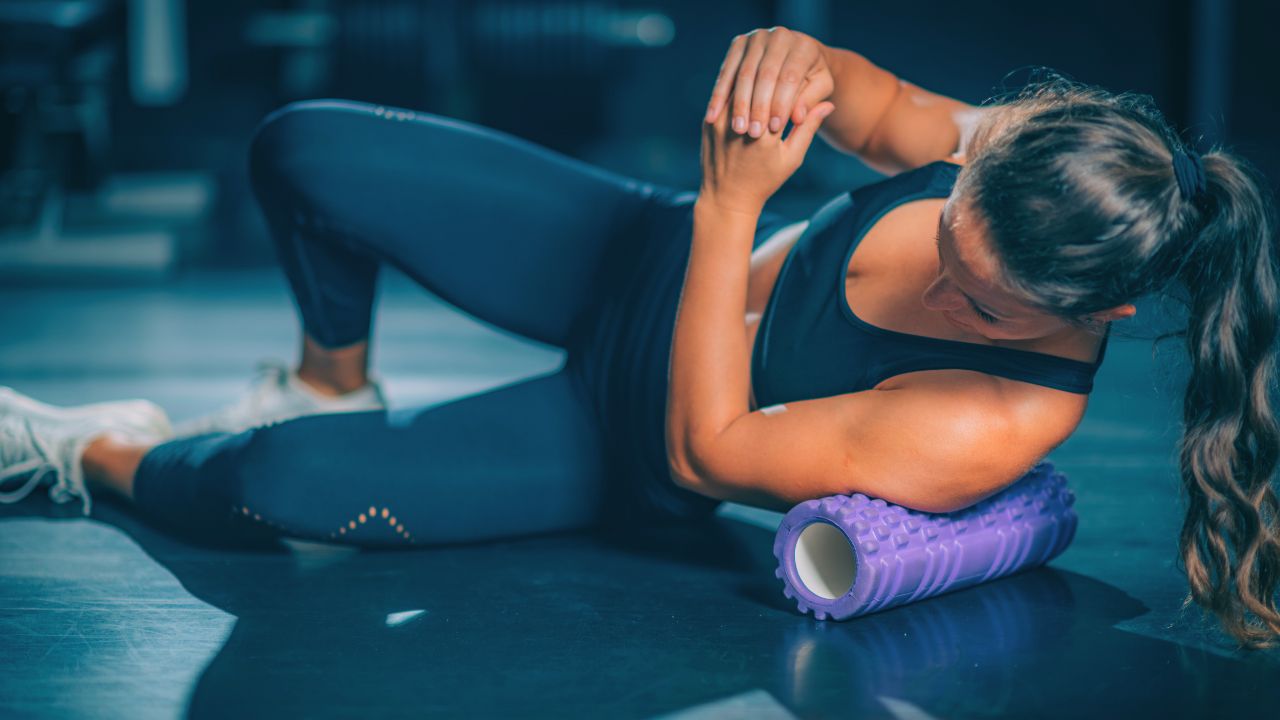
- Shoulder Foam Rolling: What & How
- Why Shoulder Foam Rolling Is Needed
- Best Foam Roller Exercises For Shoulder
- 1. Side Shoulder Foam Roll
- 2. Front Shoulder Roll
- 3. Front Shoulder Hold And Stretch
- 4. Foam Roll Neck
- 5. Lats Foam Roll
- 6. Chest Opener Foam Roll
- 7. Rotator Cuff Foam Roll
- 8. Scapular Squeeze on Foam Roller
- 9. Foam Roller Wall Slide
- 10. Shoulder Stretch on Foam Roller
- Tips For Shoulder Foam Rolling
- FAQs
- Is foam rolling good for shoulder pain?
- Can foam rolling be harmful to the shoulders?
- How often should I foam roll my shoulders?
- Shoulder foam roller stretches
- Takeaways
Shoulder Foam Rolling: What & How
Foam rolling is a form of self-massage that uses a cylindrical foam roller to apply targeted pressure to your muscles.
It’s a type of self-myofascial release (SMR) that focuses on releasing tension within the fascia, the tough connective tissue surrounding your muscles.
The pressure helps release muscle and fascia tension, improving mobility and reducing pain. When you roll over a tight or sore area, you may feel discomfort or even pain, but this is a sign that the technique works.
Over time, foam rolling can help to improve your shoulder range of motion and reduce muscle soreness.
They help release tension and relieve pain by realigning and massaging the shoulder blades and opening up the upper body.
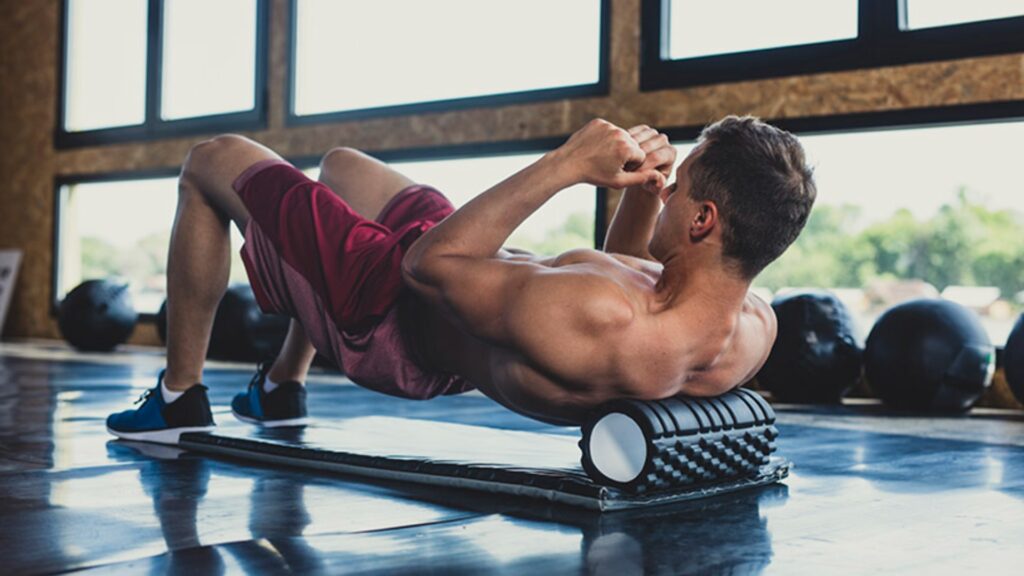
Why Shoulder Foam Rolling Is Needed
Most of us have tension in our upper back, neck, and shoulders due to constant hunching over a computer at work, looking at our phones, and sitting and driving.
This constant slumping can create stiffness, tightness over time, not to mention postural imbalances.
Here are the primary benefits of foam rolling.
- Shoulder foam rolling can be beneficial for easing sore muscles and reducing inflammation.
- They help reduce soreness after an exercise session to promote the recovery process.
- Myofascial release can break up the developed scar tissue and trigger points, allowing these muscles to stretch further and develop back to normal, increasing their range of motion.
- Foam rolling breaks up the built-up scar tissue in the muscles and increases blood flow, boosting recovery.
- Foam rolling will stretch and lengthen your muscles, help restore your full range of motion, and allow your muscles to load and perform better during sport and exercise, which, in turn, will prevent injury.
- Many people find foam rolling to be relaxing. Breaking uptightness in your muscles may help you feel less tense and calmer.
- It provides many benefits, such as helping increase joint mobility and range of motion.
- Realigning and massaging the shoulder blades helps release tension and relieve pain.
Best Foam Roller Exercises For Shoulder
There are several techniques for foam rolling the shoulders, each targeting different areas of the shoulder muscles.
To relieve pain and tightness in your shoulder, do these exercises 3–4 times per week, even if your symptoms improve.
1. Side Shoulder Foam Roll
The side shoulder (lateral deltoid) foam roll is a form of self-myofascial release that targets the muscles on the side of your shoulder, such as the deltoids.
Benefits:
- Relieves tension and tightness in the side shoulder muscles
- Reduces pain and soreness
- Improves mobility and range of motion
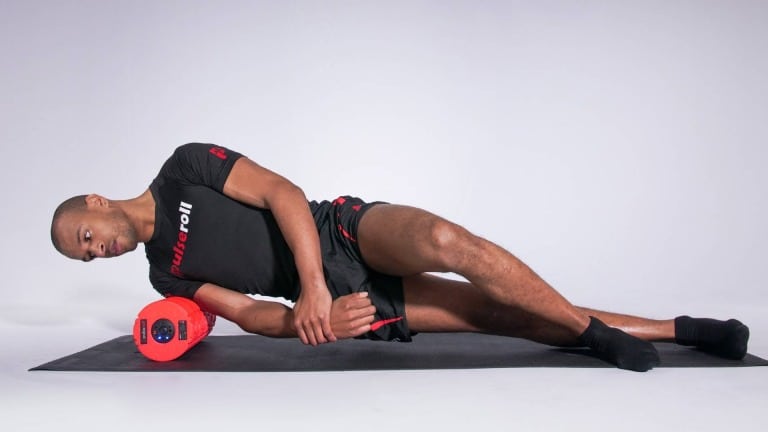
How To Do
- Lay on your side with both knees bent. Place the roller under the shoulder.
- Place your other hand on the ground in front of you to support
- Slowly roll the foam roller up and down the side of your shoulder, focusing on any tight or sore spots
- If you find a particularly tender area, hold the foam roller in place for 20–30 seconds to allow for deeper pressure
- Repeat on the other side
Tips
- Start with a softer foam roller if you are new to foam rolling or have particularly sensitive shoulders
- Avoid rolling directly on your shoulder joint
- Control the amount of pressure you apply to the foam roller
- Breathe deeply and relax into the stretch to maximize its benefits
2. Front Shoulder Roll
The front shoulder roll, also known as the anterior deltoid roll, targets the front side of shoulder muscles and helps to release tension and improve mobility in the shoulder joint.
According to a published study, foam rolling has been found to enhance shoulder flexibility and alleviate muscle soreness.
Benefits:
- Reducing muscle tension and soreness in the front delt and chest.
- Enhancing performance in exercises that involve shoulder movements, such as bench press, overhead press, and push-ups
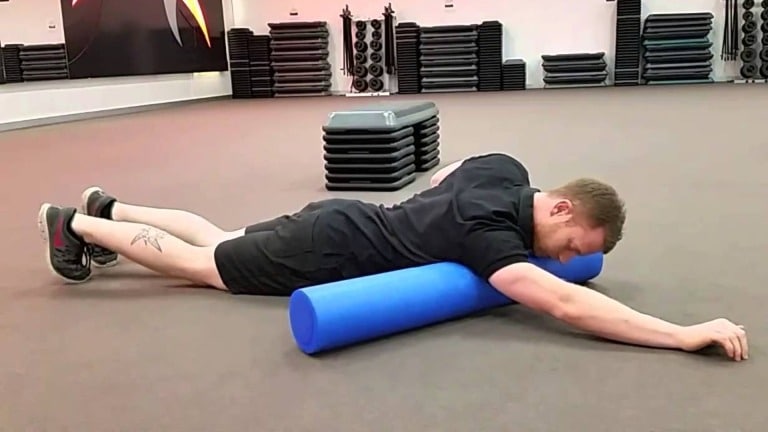
How To Do
- Place the foam roller under the upper chest where it meets the shoulder while using the other arm for support.
- Find a comfortable position for your lower body, and push the roller a few centimeters forward and backward with your upper body.
- Stopping and holding on to any tight spots for 20-30 seconds.
- Repeat on the other side.
Tips
- Start with a softer foam roller if you’re new to foam rolling or have sensitive shoulders.
- Avoid rolling directly over the bone and focus on the muscle tissue.
3. Front Shoulder Hold And Stretch
Front shoulder hold and stretch require applying pressure with a foam roller while holding a stretch in the front shoulder muscles.
Benefits:
- Improve shoulder mobility,
- Reduce muscle tightness and soreness
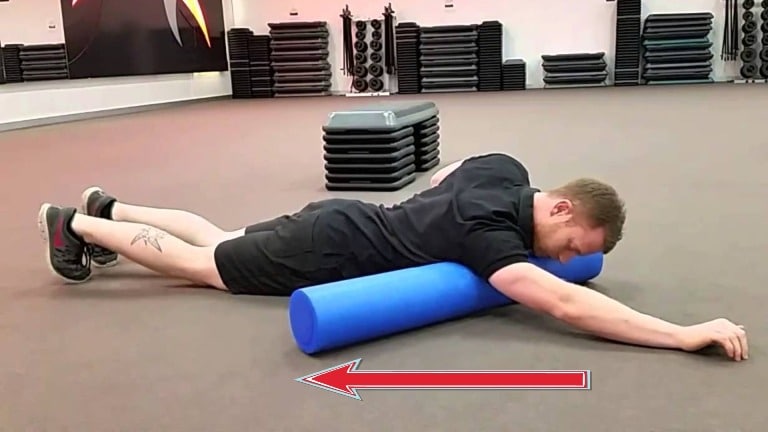
How To Do
- Place the foam roller under the upper chest where it meets the shoulder while using the other arm for support.
- Keeping the roller fixed, pulling the arm in a downward motion.
- Push the arm forwards as you were going to straighten it.
- When you find a tender spot, hold the stretch for 10–30 seconds while taking deep breaths.
- Release and move on to the next tender spot.
Tips
- It is important to keep the roller stable.
- Gradually increase the intensity and duration of the exercise over time.
4. Foam Roll Neck
Neck pain is a common issue in adults, caused by various factors such as poor posture, overuse, and sleeping wrong. Studies suggest that 14-71% of adults experience neck pain at some point in their lives.
It can lead to discomfort and inconvenience and even cause back, shoulder, and arm pain.
Using a foam roller can be a simple solution to relieve neck pain and prevent chronic pain.
Benefits:
- Reducing neck pain and stiffness
- Improving range of motion in the neck
- Promoting better posture
- Reducing headaches
- Reducing stress and tension
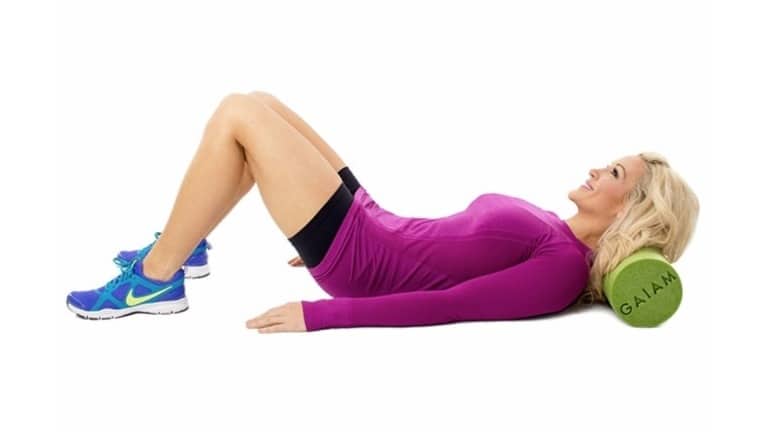
How To Do
- Lay on your back on a yoga mat or soft workout surface with a foam roller placed length ways under your neck.
- Keep your feet flat on the ground and your knees pointing upwards.
- Slowly turn your head to the right, holding where you feel a tightness.
- Exhale and turn your head to the left. Repeat for 10–30 seconds.
- Repeat the side-to-side rotation to relieve neck tension.
Tips
- Be gentle and start with less pressure
- Do not roll back and forth, only rotate side to side.
Related: Foam Roller: Best Exercises, Benefits, Tips, And How To.
5. Lats Foam Roll
Foam rolling the lats applies pressure to the lats muscles, which are located on the sides of the upper back.
The exercise is beneficial as it targets a challenging area to stretch. The roller acts like a deep tissue massage by kneading and pressing the lats, releasing small knots and tight spots.
Benefits:
- It benefits weightlifters and athletes, as it can help relieve sore muscles and prevent injury.
- Reduces muscle tension and soreness in the lats
- Improves flexibility and range of motion in the shoulders and upper back
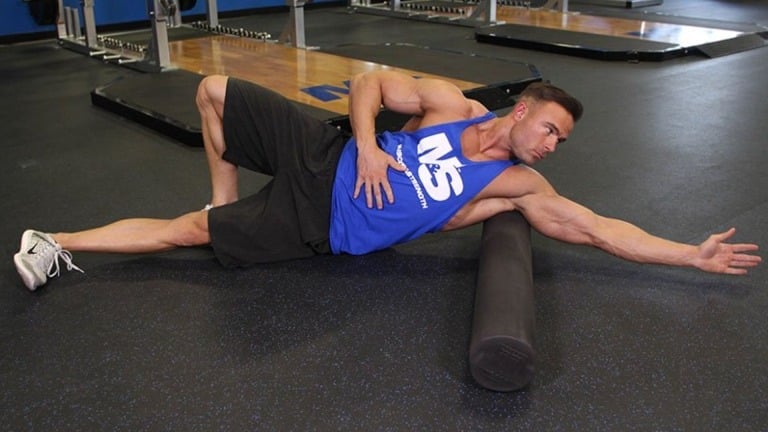
How To Do
- Lay on your side and extend the bottom leg. Bend your top knee and keep your foot firmly pressed to the floor.
- Place the roller under the armpit and extend the bottom arm.
- Length the arm with the palm facing upwards.
- Then, use your legs to slowly shift your body 10–15 cm upwards and downwards.
- Repeat on the other side
Tips
- Be careful not to roll too close to the shoulder joint, which can cause discomfort or injury.
- Use your free hand to support your body weight and control the pressure applied by the foam roller.
- Pause for 5–6 seconds on tender spots and take slow, deep breaths to relax.
Read More: Foam Roller Exercises For Back To Improve Pain & Flexibility
6. Chest Opener Foam Roll
The chest opener foam roll is an exercise that uses a foam roller to stretch and open up the chest muscles, which can become tight and restrictive due to poor posture or too much sitting.
Chest opener Improves posture by preventing rounded shoulders and hunching that comes with long hours of sitting or computer work.
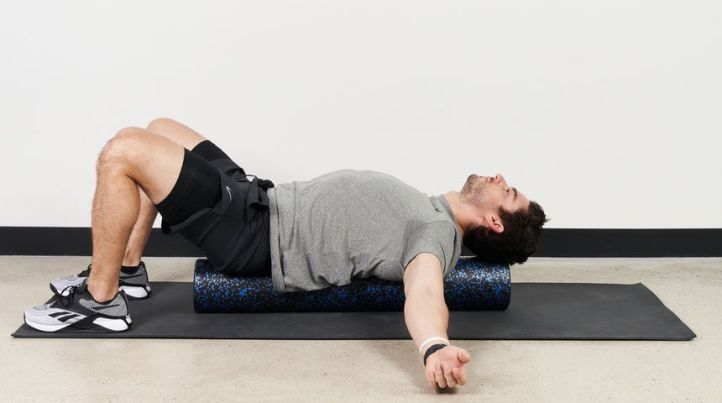
Benefits:
- It helps to reduce shoulder pain and tightness by opening up the chest muscles and reducing shoulder tension.
- Increases shoulder mobility and flexibility by stretching the anterior deltoids, pec major, and pec minor muscles.
How To Do
- Place the foam roller horizontally on the ground and sit in front of it with your knees bent and feet flat on the ground.
- Lie back on the foam roller so that it is positioned across your upper back and shoulder blades.
- Spread your arms wide and out to the sides, with your palms facing upward.
- Take deep breaths and relax into the stretch, holding for 30–60 seconds before rolling off the foam roller.
Tips
- Be sure to keep your head and neck supported throughout the stretch.
- If the stretch is too intense, try using a smaller foam roller.
- Focus on breathing deeply and relaxing into the stretch.
7. Rotator Cuff Foam Roll
- Foam roller rotator cuff exercise is a self-myofascial release technique designed to relieve tension and improve mobility in the rotator cuff muscles.
- The rotator cuff is a group of muscles and tendons that surround the shoulder joint and help to stabilize and move the shoulder.
Benefits:
- Improve shoulder mobility, reduce pain and tension in the rotator cuff muscles, and prevent injury.
- Improve posture and range of motion in the shoulder joint, making it useful for athletes and individuals who perform overhead activities.
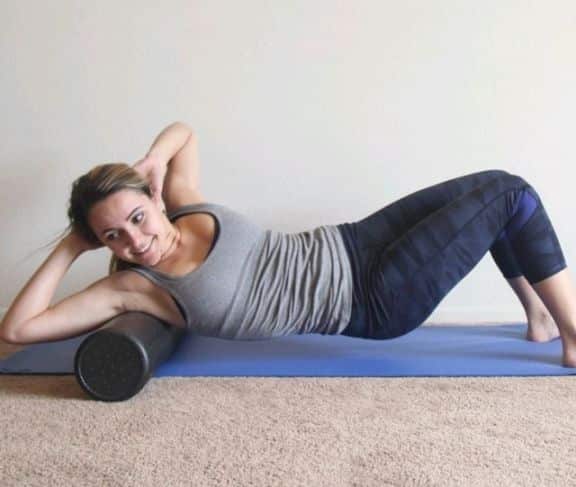
How to Do
- Place the foam roller under your armpit.
- Lie on your right side and raise your right arm above your head.
- Once you’re comfortable and stable, repeatedly rotate your body from your side to your back.
- Repeat on the other side.
- Avoid rolling directly on the shoulder joint to prevent injury.
8. Scapular Squeeze on Foam Roller
The scapula is a flat bone in the upper back that connects the shoulder blades to the collarbone.
Scapular squeeze on foam roller exercise is a stretching and strengthening exercise that targets the upper back and shoulders muscles.
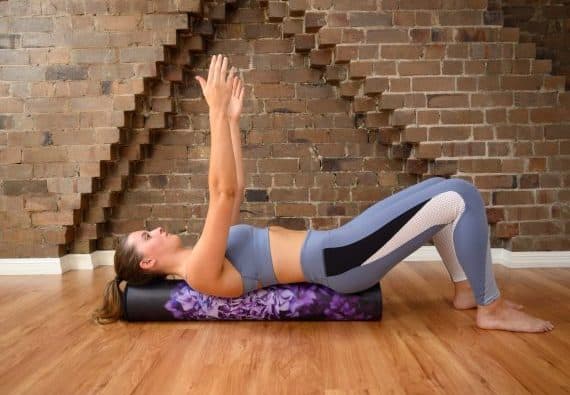
Benefits:
- It improves posture, reduces pain and tension in the upper back and shoulders, and prevents injuries.
- Also, it can help improve shoulder mobility and range of motion.
How to Do
- Lie with your back on the foam roller and your knees bent.
- Raise both arms in the air so that your hands are directly over your shoulders, palms facing each other.
- Place the foam roller horizontally between your shoulder blades
- Gently squeeze both shoulder blades together around the roller.
- Then, gently reach both hands a little towards the ceiling, using shoulder blade muscles only.
- Repeat this movement 10 times.
- Next, repeat the exercise 5–10 times with each arm on its own.
Tips
- Keep elbows straight,
- Keep your tummy tight throughout.
- Keep breathing normally throughout the roller reach and squeeze exercise.
Read More: How To Do Scapula Push Ups And Its Other Variations
9. Foam Roller Wall Slide
Serratus wall slides are a strengthening and stability exercise for the shoulder protractors and up rotators.
By performing this exercise regularly, you can improve your shoulder strength and stability.
The beginner can try scapular wall slides for strengthening the upper back muscles and improving scapular strength and mobility.
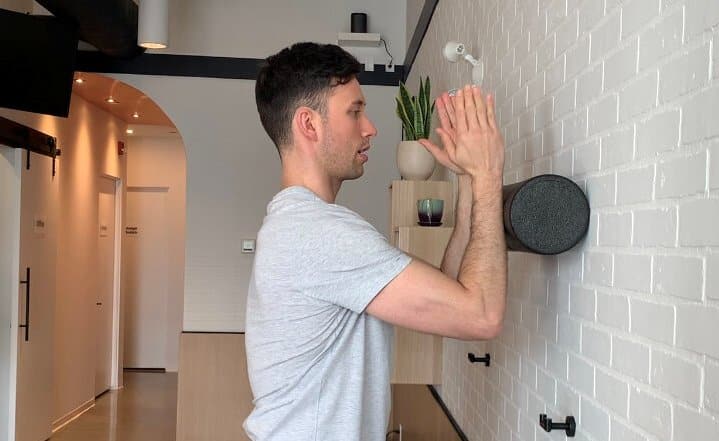
Benefits:
- Strength Serratus Anterior
- Strength Lower Trapezius
- Strength Upper Trapezius
How to Do
- Stand facing a wall with a foam roller between your forearms just below shoulder height.
- Push your elbows into the foam roller while pushing your shoulder blades forward.
- Keep this pressure as you roll the foam roller upwards and back downwards to the starting position.
10. Shoulder Stretch on Foam Roller
- Relieves tension and tightness in the shoulders
- Strengthen Latissimus Dorsi and Thoracic Spine
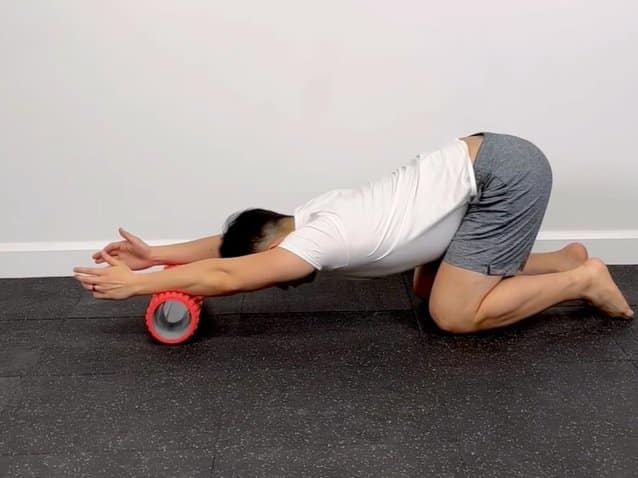
How To Do
- Sit back on your calves and place your hands on the foam roller.
- Keep the base of your palms on the roller and extend your arms overhead, with your hands positioned wider than shoulder-width apart.
- Hold the stretch for 5 seconds, then alternate by pressing your hands downwards into the foam roller for 5 seconds before returning to the starting position.
- Repeat the sequence as desired.
Know More: Foam Roller Exercises For Leg Including Hips & Glutes
Tips For Shoulder Foam Rolling
- It’s important not to roll over an area for too long, or you might experience bruising.
- Try to identify your trigger point, and maintain constant pressure over the area for at least 10–30 seconds while slowly breathing, any discomfort or tenderness will gradually ease.
- It’s always best to start light with a manageable amount of pressure and then slowly increase it as your body relaxes.
- Slowly and specifically roll each targeted muscle for 1–2 minutes and rest between sets.
- Try to relax while foam rolling. This will reduce the possibility of cramps.
- Avoid rolling over your joints — knees, elbows, and ankles.
- Rolling out can do more harm than good when it is done over the wrong areas, such as directly over a joint or bone.
- If an area is too painful to apply direct pressure, shift the roller and apply pressure to the surrounding area to loosen the entire area gradually.
- After foam rolling, perform some gentle static stretches to promote further flexibility.
FAQs
Is foam rolling good for shoulder pain?
Yes, foam rolling can be a good way to reduce shoulder pain and stiffness by releasing tension in the muscles and fascia around the shoulder joint.
Can foam rolling be harmful to the shoulders?
If done incorrectly, foam rolling can cause further injury or aggravate existing conditions.
It is important to use proper form, start with light pressure, and avoid rolling directly on bones, joints, or areas of pain or discomfort.
How often should I foam roll my shoulders?
It is recommended that you foam roll for 5–10 minutes daily, 3–5 times per week. However, the frequency and duration of foam rolling should be adjusted to your needs.
Shoulder foam roller stretches
Here are some shoulder foam roller stretches that you can try:
- Foam roller rotator cuff stretch
- Scapular squeeze on foam roller
- Foam roller chest stretch
Takeaways
Foam roller exercises are a great way to eliminate shoulder and neck aches and pains. They can also ease sore muscles and reduce inflammation.
The foam roller exercises for shoulders help increase joint mobility and range of motion.
If you have any pre-existing shoulder conditions or injuries, consult with a healthcare professional before performing foam roller exercises.

Manish brings over 10 years of hands-on experience in weight lifting and fat loss to fitness coaching. He specializes in gym-based training and has a lot of knowledge about exercise, lifting technique, biomechanics, and more.
Through “Fit Life Regime,” he generously shares the insights he’s gained over a decade in the field. His goal is to equip others with the knowledge to start their own fitness journey.
